Items filtered by date: May 2022
Causes of Itchy Feet
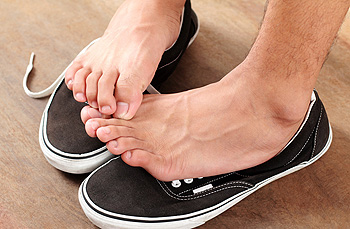
A number of conditions can cause your feet to itch. The first and probably most common cause is athlete’s foot, a fungal infection that is annoying but treatable. Symptoms of athlete’s foot include itching, redness, flaking skin between the toes or on the bottom of the feet. Another cause of itching feet is eczema, a type of skin condition that may resemble athlete’s foot but is not caused by a fungus. Instead it is thought to be caused by dry skin that is more vulnerable to irritation and allergens. Sometimes itchy and scaly skin can be caused by contact dermatitis, generally from an allergen or other irritant. Itchy feet may also be the result of psoriasis, an autoimmune disease that causes skin cells to regenerate too quickly. Hives, also known as urticaria, may cause itching, along with welts, burning or stinging. Food, medication, or a viral infection may set it off. Neuropathy, numbness caused by damaged nerves, also may result in itchiness as the body produces cytokines that can irritate the skin. If itchy feet become a serious or an ongoing problem, it is suggested that you consult a podiatrist for an examination and diagnosis.
Everyday foot care is very important to prevent infection and other foot ailments. If you need your feet checked, contact one of our podiatrists from Pennsylvania. Our doctors can provide the care you need to keep you pain-free and on your feet.
Everyday Foot Care
Often, people take care of their bodies, face and hair more so than they do for their feet. But the feet are a very important aspect of our bodies, and one that we should pay more attention to. Without our feet, we would not be able to perform most daily tasks.
It is best to check your feet regularly to make sure there are no new bruises or cuts that you may not have noticed before. For dry feet, moisturizer can easily be a remedy and can be applied as often as necessary to the affected areas. Wearing shoes that fit well can also help you maintain good foot health, as well as making it easier to walk and do daily activities without the stress or pain of ill-fitting shoes, high heels, or even flip flops. Wearing clean socks with closed shoes is important to ensure that sweat and bacteria do not accumulate within the shoe. Clean socks help to prevent Athlete’s foot, fungi problems, bad odors, and can absorb sweat.
If you have any questions please feel free to contact one of our offices located in Plymouth Meeting and Ambler, PA . We offer the newest diagnostic and treatment technologies for all your foot and ankle needs.
Protecting Yourself from Athlete’s Foot
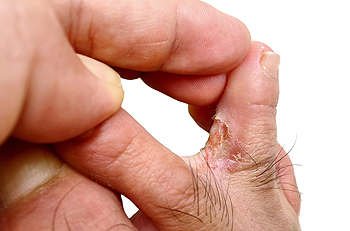
Tinea pedis is the medical term for a fungal infection that occurs on the feet, known as athlete’s foot. Since the fungus prefers warm, damp, dark environments, it can live in shoes, locker rooms, communal showers and swimming pool areas. Athlete’s foot is highly contagious—from both direct contact as well as indirect contact with a surface or object contaminated by the fungus. That is why it is vital to protect yourself in public spaces such as these with proper footwear. Avoid walking barefoot or sharing towels, shoes, or personal grooming utensils. Tinea pedis may spread to other parts of the body if left untreated. The symptoms of athlete’s foot include a dry, itchy, red, scaly rash that can appear on top of the foot, in between the toes, and even on the bottom of the feet. The skin may blister, crack or become inflamed, and a bacterial infection may develop in severe cases of athlete’s foot. If you contract athlete’s foot, the best course of action is to place yourself under the care of a podiatrist for proper, prompt, and permanent treatment.
Athlete’s Foot
Athlete’s foot is often an uncomfortable condition to experience. Thankfully, podiatrists specialize in treating athlete’s foot and offer the best treatment options. If you have any questions about athlete’s foot, consult with one of our podiatrists from Pennsylvania. Our doctors will assess your condition and provide you with quality treatment.
What Is Athlete’s Foot?
Tinea pedis, more commonly known as athlete’s foot, is a non-serious and common fungal infection of the foot. Athlete’s foot is contagious and can be contracted by touching someone who has it or infected surfaces. The most common places contaminated by it are public showers, locker rooms, and swimming pools. Once contracted, it grows on feet that are left inside moist, dark, and warm shoes and socks.
Prevention
The most effective ways to prevent athlete’s foot include:
- Thoroughly washing and drying feet
- Avoid going barefoot in locker rooms and public showers
- Using shower shoes in public showers
- Wearing socks that allow the feet to breathe
- Changing socks and shoes frequently if you sweat a lot
Symptoms
Athlete’s foot initially occurs as a rash between the toes. However, if left undiagnosed, it can spread to the sides and bottom of the feet, toenails, and if touched by hand, the hands themselves. Symptoms include:
- Redness
- Burning
- Itching
- Scaly and peeling skin
Diagnosis and Treatment
Diagnosis is quick and easy. Skin samples will be taken and either viewed under a microscope or sent to a lab for testing. Sometimes, a podiatrist can diagnose it based on simply looking at it. Once confirmed, treatment options include oral and topical antifungal medications.
If you have any questions, please feel free to contact one of our offices located in Plymouth Meeting and Ambler, PA . We offer the newest diagnostic and treatment technologies for all your foot care needs.
How Did I Get an Ingrown Toenail?
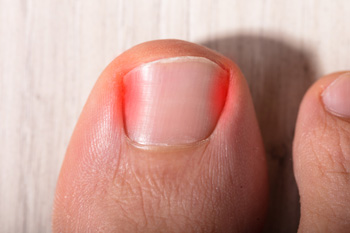
The medical term for an ingrown toenail is onychocryptosis. It is a painful foot condition that occurs when the toenail grows into the skin on the side of the nail. It can happen as a result of wearing shoes that do not fit properly. Additionally, it may happen from cutting the toenails incorrectly. The proper way to trim toenails is to cut them straight across, and not rounded. Ingrown toenails typically affect the big toe, and research has shown it is a more common condition among men rather than women. Incurring a foot injury may lead to developing an ingrown toenail. This can happen if the foot is jammed against a piece of furniture, or has become damaged from a heavy object dropping on it. Common symptoms of an ingrown toenail include redness, tenderness, and pain. It may feel better when the affected toe is soaked in warm water, which can make it easier to gently pull the skin away from the nail. It is suggested that if you have an ingrown toenail you are under the care of a podiatrist who can offer you proper treatment methods.
Ingrown toenails can become painful if they are not treated properly. For more information about ingrown toenails, contact one of our podiatrists of Pennsylvania. Our doctors can provide the care you need to keep you pain-free and on your feet.
Ingrown Toenails
Ingrown toenails occur when a toenail grows sideways into the bed of the nail, causing pain, swelling, and possibly infection.
Causes
- Bacterial infections
- Improper nail cutting such as cutting it too short or not straight across
- Trauma to the toe, such as stubbing, which causes the nail to grow back irregularly
- Ill-fitting shoes that bunch the toes too close together
- Genetic predisposition
Prevention
Because ingrown toenails are not something found outside of shoe-wearing cultures, going barefoot as often as possible will decrease the likeliness of developing ingrown toenails. Wearing proper fitting shoes and using proper cutting techniques will also help decrease your risk of developing ingrown toenails.
Treatment
Ingrown toenails are a very treatable foot condition. In minor cases, soaking the affected area in salt or antibacterial soaps will not only help with the ingrown nail itself, but also help prevent any infections from occurring. In more severe cases, surgery is an option. In either case, speaking to your podiatrist about this condition will help you get a better understanding of specific treatment options that are right for you.
If you have any questions please feel free to contact one of our offices located in Plymouth Meeting and Ambler, PA . We offer the newest diagnostic and treatment technologies for all your foot and ankle needs.
Wounds That Don't Heal Need to Be Checked
What You Need to Know About Foot Blisters
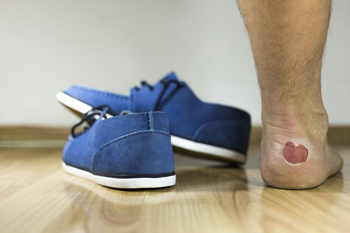
A foot blister is a small fluid-filled pocket that forms on the foot. Blisters can develop on the feet for several reasons, including friction from footwear, a fungal or bacterial infection, prolonged standing or foot use, a trauma to the foot, or even a sunburn. A blister will usually heal when the underlying cause is identified and eliminated. But if you have a blister on your foot, it can make standing, walking, or exercising uncomfortable. Simple home treatments can be employed to treat some blisters, such as wearing properly fitted shoes and socks or covering the blister with a bandage until it hardens and disappears. If a blister worsens or does not go away in a reasonable time frame, it is suggested you consult a podiatrist for a customized treatment regimen.
Blisters are prone to making everyday activities extremely uncomfortable. If your feet are hurting, contact one of our podiatrists of Pennsylvania. Our doctors can provide the care you need to keep you pain-free and on your feet.
Foot Blisters
Foot blisters develop as a result of constantly wearing tight or ill-fitting footwear. This happens due to the constant rubbing from the shoe, which can often lead to pain.
What Are Foot Blisters?
A foot blister is a small fluid-filled pocket that forms on the upper-most layer of the skin. Blisters are filled with clear fluid and can lead to blood drainage or pus if the area becomes infected.
How Do Blisters Form?
Blisters on the feet are often the result of constant friction of skin and material, usually by shoe rubbing. Walking in sandals, boots, or shoes that don’t fit properly for long periods of time can result in a blister. Having consistent foot moisture and humidity can easily lead to blister formation.
Prevention & Treatment
It is important to properly care for the affected area in order to prevent infection and ease the pain. Do not lance the blister and use a Band-Aid to provide pain relief. Also, be sure to keep your feet dry and wear proper fitting shoes. If you see blood or pus in a blister, seek assistance from a podiatrist.
If you have any questions, please feel free to contact one of our offices located in Plymouth Meeting and Ambler, PA . We offer the newest diagnostic and treatment technologies for all your foot care needs.
Diabetic Foot Ulcers
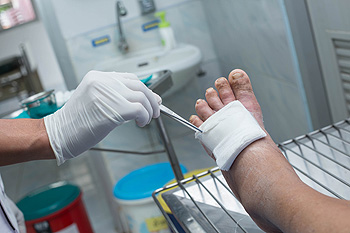
If one’s diabetes is not carefully managed through diet, exercise, and insulin treatment, an all-too-common complication can be a foot ulcer. Ulcers develop because skin tissue breaks down and layers of skin underneath are exposed due to poor circulation, high blood sugar, nerve damage, and irritated or hurt feet. Foot ulcers usually develop under big toes or the balls of the feet. Symptoms to watch for are unusual swelling, irritation, redness, discoloration, drainage from the foot, and odors emanating from the feet. The most visible sign of a foot ulcer is when black tissue (known as “eschar”) surrounds the ulcer because of poor blood flow to the area. However, signs of a foot ulcer are not always present or obvious. Good foot care, including wearing properly fitting, quality shoes, maintaining good foot hygiene, proper trimming of toenails, as well as attention paid to other aspects of physical health, such as heart and kidney disease and obesity, can help with the prevention of foot ulcers. Treatment depends on the cause and severity of the ulcer. It is highly suggested to consult with a podiatrist for proper diagnosis and to obtain a treatment plan.
Wound care is an important part in dealing with diabetes. If you have diabetes and a foot wound or would like more information about wound care for diabetics, consult with one of our podiatrists from Pennsylvania. Our doctors will assess your condition and provide you with quality foot and ankle treatment.
What Is Wound Care?
Wound care is the practice of taking proper care of a wound. This can range from the smallest to the largest of wounds. While everyone can benefit from proper wound care, it is much more important for diabetics. Diabetics often suffer from poor blood circulation which causes wounds to heal much slower than they would in a non-diabetic.
What Is the Importance of Wound Care?
While it may not seem apparent with small ulcers on the foot, for diabetics, any size ulcer can become infected. Diabetics often also suffer from neuropathy, or nerve loss. This means they might not even feel when they have an ulcer on their foot. If the wound becomes severely infected, amputation may be necessary. Therefore, it is of the upmost importance to properly care for any and all foot wounds.
How to Care for Wounds
The best way to care for foot wounds is to prevent them. For diabetics, this means daily inspections of the feet for any signs of abnormalities or ulcers. It is also recommended to see a podiatrist several times a year for a foot inspection. If you do have an ulcer, run the wound under water to clear dirt from the wound; then apply antibiotic ointment to the wound and cover with a bandage. Bandages should be changed daily and keeping pressure off the wound is smart. It is advised to see a podiatrist, who can keep an eye on it.
If you have any questions, please feel free to contact one of our offices located in Plymouth Meeting and Ambler, PA . We offer the newest diagnostic and treatment technologies for all your foot care needs.

